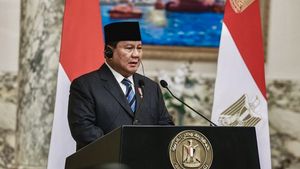JAKARTA - Persija Jakarta. The discussions surrounding the Capital Club are always interesting. Player life. Transfer activity. Even history. Regarding history, do you know the origin of the nickname Macam Kemayoran for Persija Jakarta? Here it is, the story of Murtado, the Tiger of Kemayoran.
Forward .. Forward .. Persija ..
Go forward Persija never back down ...
Show your fangs, subdue your opponent ..
We always support you..
Jakmania, a loyal fan of Perija Jakarta, almost always chants above every time the Kemayoran Tigers compete. The legend of Persija Jakarta, Bambang Pamungkas tells his stories with this magical moment in the book Bepe 20: Pride (2014).
According to Bepe - Bambang's nickname, Persija's life is in the nickname of the Kemayoran Tiger. This nickname will always live up to the support of Jakmania.
"Our support will not only ease their burden, but will also give this team additional strength, confidence and confidence so that it will motivate our 'tigers' to fight to fly the banner of the Kemayoran Tigers," he wrote.
Jakmania has always managed to see football as a team sport, not just an individual. In line with that, fanaticism for the club has increased. The supporters are always one step ahead in seeing the strengths and weaknesses of the team.
The nickname of the Kemayoran Tiger is a kind of prestige that gradually becomes a mantra to foster a new culture and identity. With the nickname "Macan Kemayoran", everyone who chants will feel like an important part of the Club.
"I am very sure, the spirit of the Kemayoran Tiger is still in your chest, heart and soul," added Bepe when remembering his late friend who was also Jakmania, Gugun Gondrong.

The early history of the name Macan Kemayoran came from none other than a Betawi champion named Murtado. Although not as popular as Si Pitung and Si Jampang, regarding their martial arts prowess, they can be pitted. Not without reason, Murtado was nicknamed the Kemayoran Tiger.
As proof of his greatness, Murtado often appears in books, so that many of the stories of Murtado have been transformed into folk tales. A story about Murtado relates it to the courage of the Betawi people against Dutch arbitrariness. Amanda Clara, in the book Folklore From Sabang to Merauke (2008) tells this story.
It is said that Murtado, who was born in 1869, was known for his courage in defending the people from all forms of crime, both from local champions and Dutch officers. Due to its frequent use of assistance to the people of Kemayoran, the Kemayoran Tigers are becoming increasingly famous throughout Batavia.
Murtado never ran out of enthusiasm to defend the people. Later, when the seeds of evil began to appear in Kemayoran, Murtado would be the first to challenge injustice, whether it was against the Dutch directly or their henchmen. "This arbitrary action cannot be tolerated," said Murtado.
On his way, Murtado defeated many champions from other regions. To the extent that, the Company raiders were defeated one by one, including Bek Lihun. For his courage and fearlessness, the Netherlands was attracted. Start lobbying for the lure of abundant wealth so that Murtado will cooperate with the company.
However, Murtado remains in his stance defending the people of Kemayoran. The offer he ignored. For Murtado, being a colonizer to sweat the people's own sweat was a big humiliation for the Betawi people.
Furthermore, Murtado will always be the dreaded champion. This figure is included in the ranks of heroes who have positive connotations. As Margreet Van Till in the book Batavia Kala Malam (2000) often expresses goodness in positive connotations.
"Jago is the protector of society. In this case the jago does not use his power to subdue his own territory from the official authorities. But they emerge as champions of the oppressed, ”he wrote.
Not only Margreet, we also contacted a young Betawi figure, Masykur Isnan to get an overview of Murtado's figure. He said that Murtado was a complete package of representations of the true Betawi people: good at martial arts, humble, simple, and helpful for the weak.
"Betawi people in general can learn a lot from the figure of Murtado. Especially in terms of courage, consistency, and side with the weak. This was proven by Murtado who dared to reject the Dutch offer to cooperate. The Kemayoran Tigers are well aware that from the start the Dutch have acted arbitrarily in Batavia, "he told VOI, June 11.
Thanks to that, Murtado has become a legend in Betawi land. His courage and enthusiasm to defend the weak earned him the nickname Kemayoran Tiger, a nickname that emphasizes Murtado's fearless soul, which can pounce on anyone who intends to harm the people of Kemayoran.
The existence of tigers in BataviaSo, have there ever been tigers in the true sense in Batavia? The answer is absolutely no. This evidence was presented in the newspaper Java Bode (1882) which carried a report regarding the presence of tigers roaming the forests around Batavia.
'Last night, the tiger, which we mentioned earlier in this newspaper, again appeared in Pepango Village - the area around Tanjung Priok, where this tiger once again made an attack on a cow. Because the cow was badly injured, the owner then slaughtered the cow. "
"Several trained hunters from Kemajoran, among others, Mr. Simons will be hunting down these dangerous animals in the next few days, and we wish them good luck with satisfying results, ”the report said.
In 1644, VOC Governor-General Joan Maetsuijker (1653–1678) reported that he and three hundred people had hunted bulls in the Weltevreden area - an area that is now Banteng Field - which is partially still in the form of thickets. Not only are bulls being hunted, there are also tigers (tigers), pigs and various other animals that roam.
Therefore, the area was once known as a hunting ground for Dutch soldiers. As a result, hunting activities were supported by the colonial government. This is because every animal that is successfully hunted will be led to the city gate of Batavia to be taxed as much as ten percent. The existence of tigers in Batavia actually did exist.
Other evidence also comes from Hendrik E. Niemeijer, in the book Batavia Masyarakat Kolonial XVII Century (2012). He stated that when Batavia was first established, many tigers were roaming in the bush. In fact, several times appeared near the walls of the City of Batavia.
“During the first 50 years of the colony, tigers were still roaming in the bush, even near city walls. Hunters who catch or kill the 'big cat' are usually rewarded with several tens of real money taken from the Company treasury for each tiger they catch or kill, "said Hendrik.
The English, Chinese, Japanese, Arabic, and French versions are automatically generated by the AI. So there may still be inaccuracies in translating, please always see Indonesian as our main language. (system supported by DigitalSiber.id)













